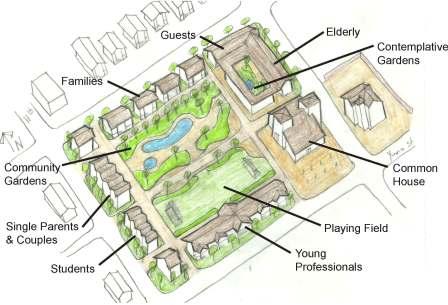 In the sixties, Flower Power Time forms of communal living were usually called commune. Less structured forms of cohabitation seem to do less well in time.
In the sixties, Flower Power Time forms of communal living were usually called commune. Less structured forms of cohabitation seem to do less well in time.
Squatting is taking a property in use without the owner's permission. Often as a reaction against the prevailing culture, consumerism and duality rich - poor. Squatters are often socially active with exhibitions, cafés or canteens (often vegetarian), and / or give away or free stores. The Guardian states that in February 2014 in the EU 11 million homes are empty, and there are 4.1 million homeless. USA: 18 million items, 3.5 million homeless.
(See: The manual of squatting, of the Centre Kraken: https://krakengent.squat.net/?page_id=5)
Anti-squatting is a form of use of vacant properties, where residents without (proper) contract shortly and inexpensively may involve a pledge to avoid it being squatted. (They are also called anti-squatters or squatter guards.)
The tenants union can help with renting problems.
Free or low cost legal assistance to get through a pro bono lawyer.
(In relation to the security of the site, most links are not active, you can google them, if they are https they will be activated again later.)
There are several formulas to live together in a small community with other people and to live collective that become popular. Housing Together of communal living is done in shared houses, kangaroo houses, cohousing, ecovillages, http://www.abbeyfield.com/.
The Little Earth in Boxtel in North Brabant (Nl) was from 1972 to 2011 as an example of a center that developed small-scale techniques to relieve the environment. Initiator Sietz Leeflang goes on with the idea into the project: The 12 Crafts.
Findhorn Foundation since 1962 is a globally known spiritual community, learning center and ecovillage. https://www.findhorn.org/aboutus/vision/history/
In 2001 B. purchased with 4 other families a castle in Deurne, near Antwerp. Today they live in a beautifully renovated castle slot. They have their privacy but share the garden and some rooms. "The luxury we have now, you cannot afford as a couple."
Official authorities and notaries gradually become more familiar with the capabilities and formulas of cohousing.
Apostolos Sianos, the 32 -year-old co-founder of the community "Free and Real" in 2008 showed dissatisfaction with the tiring city life and left his website designer job in Athens for the slopes of the Telaithrion on the rural island of Evia.
Panagiotis Kantas, co - founder, is proud of the self-sufficient and sustainable nature of the project. The crisis does not claim them really. https://www.youtube.com/watch?v=R_96v72EgVE
In Malmo in mainly poorer neighborhoods is specially room equipped for co- housing projects, because of the dynamic and positive impact on the environment. For example, implantation is even called "social acupuncture”.
Ubuntu, moving from a money-driven society to a society driven by people, their talents and their passion for life. Where everyone contributes their natural talents or acquired skills to the greatest benefit of all in their community. http://www.ubuntuparty.org.za/p/plan-of-action.html
On the website there is a mass of ideas about living, politics, education, sustainability, banks, money... In 2014, construction began on a new Ubuntu Village project: in Mpumalanga, South Africa. "If it is not good for anyone, it's not good "
A small Andalusian village of Marinaleda (60km from Antequera) fights against unemployment
The 3,000 inhabitants manage and work together on 1,200 hectares. Almost everyone is working in one of their many cooperatives. The land belongs to those who work it. Banks and real estate offices are not welcome.
One third of the population lives in self-build houses. They get the ground and an architect of the community, and guidelines from a few construction instructors. For the home, residents must pay rent only 15 euros per month.
Lakabe is a small medieval hamlet (Sp, Navarra), which was abandoned due to urbanization, but was "found" by people who were looking for their goat in 1980. A group of enthusiastic people live there largely self-sufficient and sustainable.
Living in a container is an architectural trend. The construction is strong and can be modularly stacked. Legio for cladding and interior finishing. Scientists that went to the poles for research gave the example with shipping containers.
Dr. Jeff Wilson, a professor at Huston - Tillotson University, is going to live a year in a dumpster (2014). Students will help organize a room, kitchen, bed, durable solar panels and environmentally friendly toilet.
An Earthship (Earth ship) is a building made of old car tires crammed with earth. The U - shaped, open form on the sunny side, lets light and warmth in. Non - load-bearing interior walls are often made with cans or bottles. They are usually thick plastered with adobe, clay or lime. American Michael Reynolds began in 1971 with the construction.
In the autumn of 2011 began the construction of a residential area of 23 earth houses in Olst (Nl).
Building with straw bales for sustainable housing and other durable materials (lime hemp, clay) is on the rise.
Just something hammering together yourself is now banned. You need for everything necessary permissions, and you must adhere to guidelines and rules.
A house in the West gets increasingly the function of sleep stay. After shrinking the outdoor areas are now the inner spaces (Living 30m²) smaller (except for high earners who like to make it a status symbol). Life often is very individualistic (single, small family) and who is in need of care is outsourced to institutions (serviced, nursing home).
Because of the rising costs are elderly now also 'exported' to Thailand. Actually, each local community should (could) concern for his own people, but apparently the necessary sense of community is supplanted by individuality.
https://www.ic.org/directory/intentional-communities-by-country/
